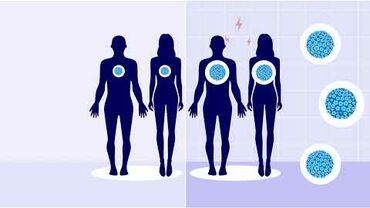Questions and answers - Point prevalence survey on healthcare-associated infections in acute care hospitals
Questions and answers - Point prevalence survey
Q. What is a point prevalence survey?
A. A prevalence survey is a count of the number of patients with a particular condition/treatment (in this case either a healthcare-associated infection or an antimicrobial agent) at a particular time (in this case a day), as a proportion of the total number of patients who are hospitalised at that particular time. A point prevalence survey only counts the condition/treatment if present at the time (on the day) of the survey, but does not count if it is present at other times during the patient stay in the hospital.
Q. What were the objectives of the 2011-2012 ECDC PPS of healthcare-associated infections (HAIs) and antimicrobial use?
A. The objectives of the ECDC PPS of HAIs and antimicrobial use in acute care hospitals were:
- to estimate the total burden (prevalence) of HAIs and antimicrobial use in acute care hospitals in the EU;
- to describe HAIs (sites, microorganisms including markers of antimicrobial resistance) and antimicrobials prescribed (compounds, indications):
• by type of patients, specialties or healthcare facilities; and
• by EU country, adjusted or stratified;
- to disseminate results to policy makers and healthcare professionals at local, regional, national and EU levels in order to:
- to raise awareness about HAIs and antimicrobial use;
- to perform training and reinforce surveillance structures and skills;
- to identify issues that are common for hospitals in EU/EEA countries and set up priorities accordingly;
- to evaluate the effect of strategies and to inform future local/regional/national policies (repeated PPS);
- to provide a standardised tool for hospitals to identify targets for quality improvement.
Q. Did you reach these objectives?
A. Yes. Despite limitations and inherent difficulties arising from the magnitude of the survey and the need for agreement on, and adherence to, uniform definitions, methodology and requirements, the ECDC PPS has:
- estimated the overall burden of HAIs and use of antimicrobials in acute care hospitals in the EU;
- described HAIs and antimicrobial use by type of hospital, patient and by country;
- increased surveillance skills through the training of approximately 2800 healthcare workers across Europe;
- disseminated the results (e.g. through feedback of the results by hospital);
- provided a standardised tool for hospitals to identify targets for quality improvement.
Q. Why was this survey undertaken?
A. Healthcare-associated infections (HAIs) represent an urgent public health issue and a threat to the safety of European patients. This EU-wide PPS serves as evidence for policy makers at EU and national level to act upon and plan effective ways to reduce HAIs in European hospitals.
In addition, with this information both infection prevention and control and antimicrobial stewardship priorities can be targeted most effectively at national and hospital level.
Q. Why didn’t you include the data submitted by all hospitals and patients in the 2011-2012 ECDC PPS?
A. Not all data were included to avoid overrepresentation of three countries (Belgium, Portugal and Spain) that submitted more than the required number of hospitals.
Frequently asked questions on healthcare-associated infections
Q. What is a healthcare-associated infection?
A. Healthcare-associated infections are infections acquired by patients during their stay in a hospital or another healthcare setting. Although some of these infections can be treated easily, others may more seriously affect a patient’s health, increasing their stay in the hospital and hospital costs, and causing considerable distress to these patients.
For the purposes of the ECDC PPS protocol, an infection was defined as being active on the day of the survey when:
1. signs and symptoms were present on the date of the survey;
OR
2. signs and symptoms were no longer present but the patient was still receiving treatment for that infection on the date of the survey. In this case, the symptoms and signs occurring from the start of treatment until the date of the survey were checked to ascertain that the infection matched one of the case definitions of HAIs.
Among active infections, some were defined as healthcare-associated (associated with acute care hospital stay only, for the purpose of this protocol) based on the following criteria:
1. the onset of the signs and symptoms was on Day 3 of the current admission or later (with Day 1 being the day of admission);
OR
2. the signs and symptoms were present on admission or became apparent before Day 3, but the patient had been discharged from an acute care hospital less than two days before admission;
OR
3. the signs and symptoms of an active surgical site infection were present on admission or started before Day 3, and the surgical site infection occurred within 30 days of a surgical intervention (or in the case of surgery involving an implant, a deep or organ/space surgical site infection that developed within a year of the intervention);
OR
4. the signs and symptoms of a Clostridium difficile infection were present on admission or started before Day 3, with the patient having been discharged from an acute care hospital less than 28 days before the current admission.
HAIs are grouped by ECDC into 13 broad categories based on the main physiological systems and surgical interventions. These are:
- Bloodstream infections
- Bone and joint infections
- Cardiovascular system infections
- Central nervous system infections
- Clinical sepsis
- Eye, ear, nose, throat and mouth infections
- Gastrointestinal infections
- Lower respiratory tract infections other than pneumonia
- Pneumonia
- Reproductive system infections
- Skin and soft tissue infections
- Surgical site infections
- Urinary tract infections
Q. Which were the most common HAIs in the 2011-2012 ECDC PPS?
A. Of a total of 15 000 reported HAIs, the most frequently reported types were respiratory tract infections (pneumonia 19.4% and lower respiratory tract infections 4.1%), surgical site infections (19.6%), urinary tract infections (19.0%), bloodstream infections (10.7%) and gastro-intestinal infections (7.7%), with Clostridium difficile infections representing 48% of the gastro-intestinal infections and 3.6% of all HAIs.
Q. Why was HAI prevalence highest amongst patients admitted to intensive care units?
A. Prevalence of HAIs was highest among patients admitted to intensive care units where 19.5% patients had at least one HAI. The most common HAI types in intensive care units were respiratory infections and bloodstream infections. Intensive care units are units where the most vulnerable patients are cared for, often with medical devices such as central vascular catheters required for their management.
Q. Which were the most frequently reported microorganisms in HAIs in the 2011-2012 ECDC PPS?
A. Less than half (45.9%) of the HAIs were reported with microbiological results on the day of the PPS. Among these, the most frequently isolated microorganisms in HAIs were: Escherichia coli (15.9%), Staphylococcus aureus (12.3%), Enterococcus species (9.6%), Pseudomonas aeruginosa (8.9%), Klebsiella species (8.7%), coagulase-negative staphylococci (7.5%), Candida species (6.1%), Clostridium difficile (5.4%), Enterobacter species (4.2%), Proteus species (3.8%) and Acinetobacter species (3.6%).
Other, less common microorganisms in HAIs were Serratia species, Stenotrophomonas maltophilia and Aspergillus species, which accounted for 1.1%, 1.0% and 0.4% of all reported microorganisms, respectively. Although less frequent, these microorganisms are important because of their epidemic potential or intrinsic resistance to antimicrobials.
Q. In 2008, ECDC said that 4.1 million patients are estimated to acquire a healthcare-associated infection in the EU every year. The estimate in this report is almost one million lower. Does that mean that we are doing better?
A. No, it does not mean that EU is doing better. The confidence intervals of the new estimate reported in this PPS include the estimate from 2008. This means that there is no statistical difference in the HAI prevalence in the EU as reported by ECDC in 2008 (Annual Epidemiological Report) and in this report of the ECDC PPS 2011-2012.
Q. Does a prevalence of 5.7% mean that, if I am admitted in a hospital, I have a one in 18 chances of getting a HAI?
A. No. It means that, on a given day in European hospitals, one in 18 patients has a HAI.
Frequently asked questions on antimicrobial resistance and antimicrobial use in the 2011-2012 ECDC PPS
Q. Were any of the microorganisms found resistant to antibiotics?
A. Yes. Selected antimicrobial susceptibility testing (AST) results were available on the day of the PPS for 85% of microorganisms reported in HAIs:
- Meticillin resistance (MRSA) was reported in 41.2% of Staphylococcus aureus isolates with known AST results.
- Vancomycin resistance was reported in 10.2% of Enterococcus species isolates.
- Third-generation cephalosporin resistance was reported in 33.4% of all Enterobacteriaceae isolates, and was highest in Klebsiella pneumoniae.
- Carbapenem resistance was reported in 7.6% of all Enterobacteriaceae isolates, and also highest in Klebsiella pneumoniae.
- Carbapenem resistance was reported in 31.8% of Pseudomonas aeruginosa isolates and in 81.2% of Acinetobacter baumannii isolates.
Q. What were some of the findings about antimicrobial use?
A. Some of the findings were:
- The prevalence of patients that received at least one antimicrobial agent was 32.7% (95% confidence interval: 29.4–36.2%), varying by country from 21.4% to 54.7%).
- A total of 110 151 antimicrobial agents were reported in 80 951 patients, or on average 1.4 antimicrobials per patient receiving antimicrobials: 70.9% of the patients received one antimicrobial, 23.4% received two and 5.7% received three or more antimicrobials.
- The prevalence of antimicrobial use was lowest in psychiatric patients (3.5%) and highest in patients in intensive care units (56.5%).
- Antimicrobials were administered parenterally in most (70.6%) of the cases. The reason for antimicrobial use was documented in the patient’s medical records for 79.4% of the prescribed antimicrobial agents.
- With an overall prevalence of antimicrobial use of 32.7% (95% confidence interval: 29.4–36.2%) and 466 226 (95% confidence interval: 419 284–515 690), patients were estimated to receive at least one antimicrobial on any given day in European hospitals in 2011–2012. This means that one in three patients was estimated to receive at least one antimicrobial on any given day.
- Antimicrobial agents were most frequently prescribed for treatment of an infection (68.4%): community-acquired infection (47.6%), hospital-acquired infection (19.1%) or infection acquired in a long-term care facility (1.8%).
- Surgical prophylaxis was the indication in 16.3% of prescriptions. Among these antimicrobial prescriptions for surgical prophylaxis, 59.2% were for more than one day, 15.8% were for one day and only 25.0% were for less than one day.
Frequently asked questions on infection control structures and indicators
Q. The ECDC PPS survey also gathered information on infection control structure and process indicators. Which were those?
A. Three infection control structure and process indicators were collected at the hospital level:
- the consumption of alcohol hand rub (litres consumed in the previous year) as a proxy (surrogate) indicator of hand hygiene;
- the number of single-room beds, i.e. beds in single rooms, as a proxy indicator of the capacity for isolation of patients infected or cthe
- number of single-room beds, i.e. beds in single rooms, as a proxy indicator of the capacity for isolation of patients infected or colonised with microorganisms requiring enhanced infection control measures;
- the number of full time equivalent (FTE) nurses, and doctors, available in the hospital for working specifically with infection prevention and control (at the time of the survey).
Alcohol hand rub consumption was reported as the number of litres per 1000 patient days.
Single-room beds, i.e. beds in single rooms, were reported as the percentage of single-room beds among the total number of beds in the hospital.
Frequently asked questions on recommendations and future steps
Q. What are ECDC recommendations after the survey?
A. To maximise prevention and control of HAIs and antimicrobial resistance in European healthcare institutions, the continued implementation of the Council Recommendation of 9 June 2009 on patient safety, including the prevention and control of healthcare associated infections (2009/C 151/01) is crucial. This includes:
- Having infection prevention and control programmes in place at national and hospital level.
- Ensuring adequate numbers of specialised infection control staff with time set aside for this task in hospitals and other healthcare institutions.
- Repeating national point prevalence surveys of HAIs as a means to monitor the burden of HAIs in all types of healthcare institutions, to identify priorities and targets for intervention, to evaluate the impact of interventions and to raise awareness.
- Implementation of surveillance of HAIs in intensive care units and surveillance of surgical site infections.
Based on ECDC PPS results, additional or specific recommendations can be proposed in the area of prevention and control of HAIs, antimicrobial resistance and antimicrobial use in acute care hospitals.
These suggestions include the following:
- Continued support for and monitoring of appropriate use of accurate diagnostic testing for HAIs and antimicrobial resistance in EU/EEA Member States
- Implementation of EU-standardised surveillance of alcohol hand rub consumption, complemented if possible by hand hygiene compliance monitoring.
- Implementation of standardised surveillance of C. difficile infections at local, national and EU level.
- Development of guidance for the prevention and control of HAIs with carbapenem-resistant Gram-negative bacteria.
- Enhancement of EU surveillance of HAIs with carbapenem-resistant Gram-negative bacteria, e.g. by improving the EARS-Net surveillance of antimicrobial resistance with regard to the origin of the infection (community- or healthcare-associated) and coverage of other infection types and antimicrobial resistance markers.
- Support for the timely detection of new epidemics with alert microorganisms and support the implementation of appropriate prevention and control measures accordingly, e.g. by promoting the use by Member States of the ECDC epidemic intelligence system (EPIS) for antimicrobial resistance.
- Development of antimicrobial stewardship programmes to improve antimicrobial prescribing in acute care hospitals, in particular:
o to rationalise the use of broad-spectrum antimicrobials (e.g. carbapenems);
o to limit the unnecessary prolongation of surgical prophylaxis;
o to rationalise the use of antimicrobials for medical prophylaxis;
o to promote the practice of changing the route of administration of antimicrobials from parenteral to oral when possible;
o to improve the documentation of the reason for antimicrobial prescribing in patients’ charts.
- Reporting of hospital antimicrobial consumption to ESAC-Net as a number of Defined Daily Doses (DDD) per number of patient-days (rather than per number of inhabitants).
Q. What are the main components of that Council Recommendation of 9 June 2009 on patient safety, including the prevention and control of healthcare associated infections (2009/C 151/01) with regard to HAI prevention and control?
A. The main components of Council Recommendation 2009/C 151/01 with regard to HAI prevention and control are reiterated below, together with the specific action points that were identified in the first implementation report of this Council Recommendation:
- to have infection prevention and control programmes in place at national and hospital level, including recommendations on organisational and structural arrangements, diagnostic and therapeutic procedures (for example antimicrobial stewardship), resource requirements, surveillance objectives, training and information to patients.
- to continue the development of guidance on the prevention and control of HAIs and antimicrobial resistance at EU level and have guidelines available at national and hospital level.to continue the development of guidance on the prevention and control of HAIs and antimicrobial resistance at EU level and have guidelines available at national and hospital level.
- to improve surveillance by:
o repeating national PPSs of HAIs as a means to monitor the burden of HAIs in all types of healthcare institutions, to identify priorities and targets for intervention, to evaluate the impact of interventions and to raise awareness,
o ensuring that surveillance of targeted infection types is in place, e.g. surveillance of HAIs in intensive care units and surveillance of surgical site infections,
o implementing surveillance systems for the timely detection and reporting of alert healthcare-associated microorganisms and strengthening the ability to respond to the spread (including across borders) of such microorganisms and prevent their introduction into healthcare settings,
o developing an evaluation system with a set of indicators in Member States to assess the implementation of the strategy/action plan and its success in improving the prevention and control of HAIs.
- to enhance infection prevention and control staffing and training by:
o ensuring adequate numbers of specialised infection control staff with time set aside for this task in hospitals and other healthcare institutions,
o improving the training of specialised infection control staff and better aligning qualifications between Member States.
- to improve the information on HAIs for patients and strengthen their involvement in the compliance with infection prevention and control measures.
- to develop research at EU level in the area of the prevention and control of HAIs, including studies on cost-effectiveness of prevention and control measures.
Q. What is happening with the ECDC PPS currently?
A. ECDC is currently coordinating a second EU-wide PPS in all Member States in 2016–2017.



